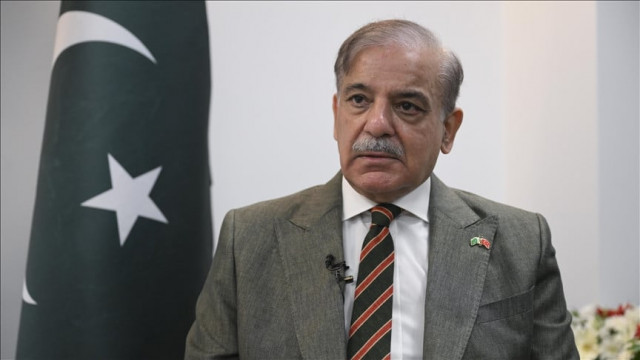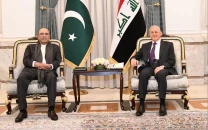PM hopes to meet IMF MD in Paris
Foreign loans disbursements fall to just $8.4b this fiscal year

Prime Minister Shehbaz Sharif has sought a meeting with the managing director of the International Monetary Fund (IMF) on the sidelines of the summit for a new Global Financial Pact in Paris amid a steep fall in foreign loans disbursements to just $8.4 billion this fiscal year.
The cabinet sources told The Express Tribune that Pakistan has requested for a meeting between PM Shehbaz and IMF Managing Director Kristalina Georgieva on the sidelines of the Paris Summit that is taking place from June 22 to 23.
The premier is expected to leave for Paris on Wednesday (today). Minister for Information and Broadcasting Marriyum Aurangzeb did not respond to a question whether a meeting was scheduled between PM and the MD on the sidelines.
PM Shehbaz in the past one month has made a telephonic contact with Kristalina and also wrote three letters to her, counting Pakistan’s efforts to revive the stalled $6.5 billion package.
The premier on Monday also met with foreign ambassadors to apprise them about Pakistan’s efforts to restore the programme.
During this summit, the issues at stake are the repercussions of the multiple climate, energy, health and economic crises, particularly in the most vulnerable countries.
The summit will look into the ways for restoring fiscal space to countries facing short-term difficulties, especially the most indebted states.
The data released by the Ministry of Economic Affairs on Tuesday disclosed that Pakistan’s foreign loan inflows during the current fiscal year have significantly dropped, reaching hardly $8.4 billion. This represents a 37% decline compared to the previous year and falls far below the annual budget estimates.
The decrease in disbursements can be attributed to major international creditors pulling back due to delays in reaching a deal with the IMF.
The receipt of $8.4 billion represents only 37% of the annual budget estimate of $22.8 billion. The government had budgeted $19.1 billion in programme loans but the actual receipts under this head remained just at $5.5 billion, according to the Ministry of Economic Affairs.
The SBP governor had said earlier that the majority of the projected loans were expected to be disbursed during the second half of the current fiscal year.
These disbursements have been insufficient to finance the maturing foreign debt, resulting in a significant dent in the country’s foreign exchange reserves, which currently stand at just $3.5 billion.
In May, Pakistan received just $473 million, which is less than the monthly external debt repayments.
The government estimated inflows of $7.6 billion in loans from multilateral agencies for the current fiscal year, but only $4.4 billion were disbursed in the first 11 months.
The Asian Development Bank (ADB) remained the largest creditor, extending over $2 billion, equivalent to 63% of the annual estimate. However, ADB disbursements have also slowed down in recent months.
The World Bank gave $1.5 billion as against the annual estimates of $2.6 billion.
A key reason behind the low disbursement by the World Bank was the delay in approval of the budget support loans that are pegged with the IMF programme.
Pakistan could not receive the $1.1 billion loan under the RISE-II and the PACE-II programmes. The Express Tribune had reported in January this year that these loans would not be approved in this fiscal year.
The Asian Infrastructure Investment Bank disbursed $553 million –slightly better than the annual estimates of $542 million. As against the annual estimate of $1.2 billion, the Islamic Development Bank released only $161 million for oil facilities.
The government had budgeted $970 million worth of bilateral loans and the target was exceeded by a wide margin on back of $1.1 billion disbursements by Saudi Arabia for oil facilities. China also gave $128 million as against the budgeted amount of $48 million. The financing from the rest of the bilateral creditors remained negligible.
Pakistan’s borrowing options have become limited due to downgraded outlooks by international credit rating agencies, negative debt ratings, and increased borrowing costs. This has virtually closed the door to floating Eurobonds.
Against an annual estimate of $7.5 billion, Pakistan has only received $900 million in foreign commercial loans in the current fiscal year. Due to credit rating-related issues, the government had to include $1.3 billion of Chinese commercial bank debt on its domestic debt balance sheet.
The planned $2 billion sovereign bond-based borrowing did not materialise due to poor credit ratings and expected high interest costs. The government also expected to receive $3 billion from the IMF, later increased to $3.5 billion, but has only received $1.2 billion so far. The remaining amount may lapse with the programme’s expiry on June 30.
The Ministry of Finance had estimated receiving $1.63 billion under the Naya Pakistan Certificates but the actual disbursements so far remained at $743 million.



















COMMENTS
Comments are moderated and generally will be posted if they are on-topic and not abusive.
For more information, please see our Comments FAQ